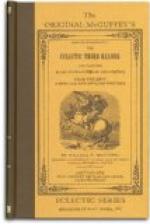When Truman & Smith began publishing, the copyright law required the deposit of titles and copies of the several books in the office of the Clerk of the District Court. At first such deposits were made in Columbus, Ohio, but later in Cincinnati. When Congress organized the Copyright Bureau in Washington, the several clerks were required to send to the Library of Congress all the sample copies deposited; but these had been carelessly kept and many were lost. A duplicate set was for years required to be sent to the Smithsonian Institution in Washington. These were also passed into the custody of the Librarian of Congress; but this collection had been carelessly preserved and the files of the McGuffey Readers at Washington are now quite defective for the earliest issues. The Library seems to have no copy of any number of the first edition except possibly the Second and Fourth. The copy of the Second was deposited December 12, 1836. The Fourth bears date of July, 1837. All the other early copies found in that library are of later dates and are “Revised and Improved.”
[Early Engravings]
It may be well to indicate in a general way the progress that has been made in illustrating schoolbooks. The first editions of the McGuffey Readers as issued in 1836 and 1837 did not contain a single original engraving. All seem to have been copied from English books. The nice little boys wear round-about jackets with wide, white ruffled collars at the neck. The proper little girls have scoop bonnets and conspicuous pantalets. Most of the men wear knee breeches. The houses shown have the thatched roofs of English cottages. In one picture a boy has a regular cricket bat. Other schoolbooks of that date show similar appropriations of English engravings; but even at that time there were a few wood engravers in America. When the second general revision was made in 1843 some original illustrations appeared and in the edition of 1853 notice was given on the title page that the engravings were copyright property that must not be used by others.
As pictures are closely studied by children, some of the users of these early books may remember the cut showing vividly the dangers of “whale catching.” Two boats are thrown high in the air by one sweep of the animal’s tail and one seaman is shown head downward still in the boat. Another represented Jonah being cast overboard from the ship toward the whale below whose mouth is manifestly large enough to accommodate Jonah.
But the engravings in this edition of 1853 had no considerable artistic quality and they were very coarsely engraved. In 1863 came the first employment of a genuine artist in wood engraving. This was Mr. E.J. Whitney who had made a reputation by work done for New York publishers. His engravings were to take the place of some then in the books and their sizes were precisely determined. The drawings were most carefully made by Mr. Herrick with pencil




